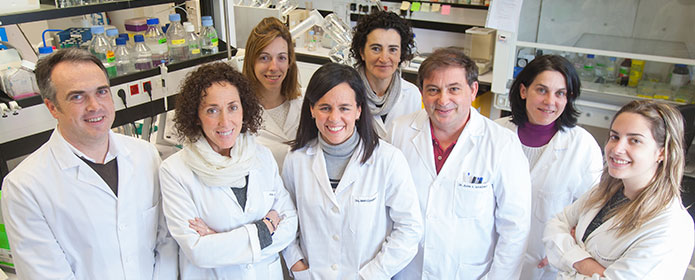Scientists at CIMA discover a molecule that eliminates the symptoms and slows the progression of Alzheimer's in mice.
Its therapeutic use in patients could restore the loss of report caused by the disease.

Scientists at research center Applied Medicine (CIMA) of the University of Navarra have discovered a new molecule that eliminates the symptoms of Alzheimer's disease, and also slows down its neurodegenerative process in mice. Thus, animals treated with CM-414 showed a decrease in the main markers of the disease (beta-amyloid peptide -the main component of the senile plaques associated with the disease that form in the brain- and phosphorylated tau protein) as well as an increase in neuronal synapses. The results of this research have been published in the scientific journal Neuropsychopharmacology, a publication of group Nature.
The new CM-414 molecule inhibits two enzymes involved in the pathology of Alzheimer's disease: histone deacetylase (HDAC) and phosphodiesterase 5 (PDE5), whose increase in the brain, verified in patient samples, is associated with the cognitive deterioration characteristic of the disease. "After simultaneous inhibition of these enzymes, whose effectiveness separately had previously been proven, we have observed a potentiation of their therapeutic effect that reverses the symptomatology and slows the progression of Alzheimer's disease in mice," says Dr. Ana García-Osta, manager of the laboratory of CIMA dedicated to Alzheimer's disease and one of the authors of article. The research has been carried out in mouse models of Alzheimer's disease which, after treatment with CM-414, the scientists evaluated their learning ability and spatial report with the Morris water maze test.
To achieve this finding researchers at CIMA first validated this new therapeutic approach by combining compounds from reference letter. Subsequently, more than 200 molecules capable of inhibiting these two enzymes were designed and synthesized, with compound CM-414 showing the greatest therapeutic potential. The results of this research were published in the Journal of Medicinal Chemistry, one of the leading scientific journals of its area.
Therapeutic potential of the new moleculeThe CM-414 molecule serves as a starting point for developing a new treatment strategy against Alzheimer's disease. The next step, says Dr. Julen Oyarzabal, also author of article and director of the Molecular Therapies Program at CIMA, "will be to optimize this compound until a molecule with an optimal profile of efficacy and safety, candidate clinical, is obtained that will allow testing in patients with this neurodegenerative disease".
The high therapeutic potential of this molecule is reflected in the latest issue of Biocentury Innovations, a leading publication providing information on cutting-edge and commercially promising translational science for biotech and pharmaceutical companies, academics, and public and private investors. Two papers from CIMA stood out from the review of more than 400 articles published in 41 high-impact journals.




